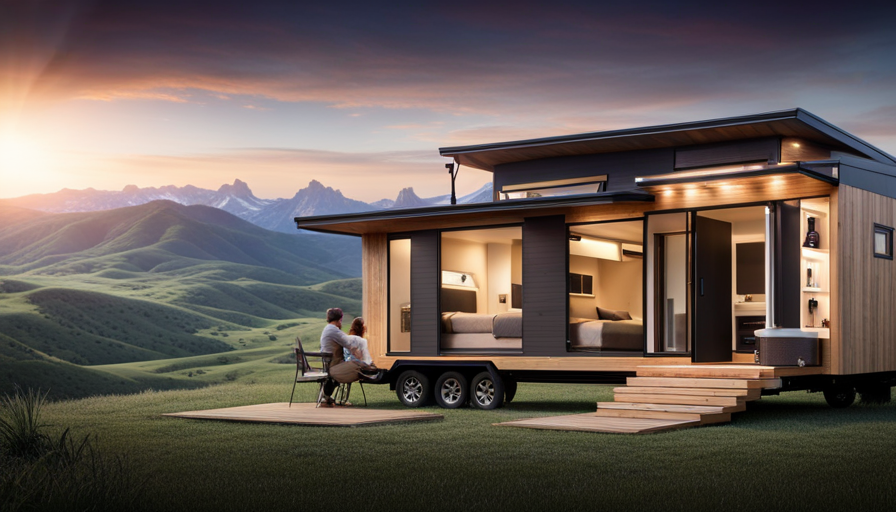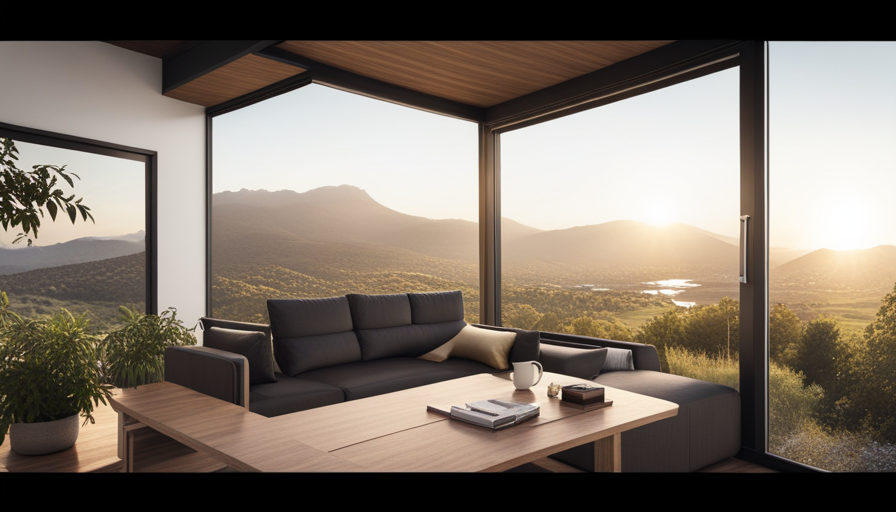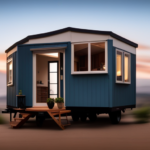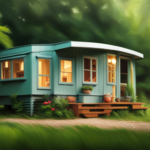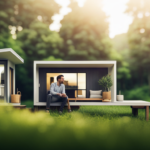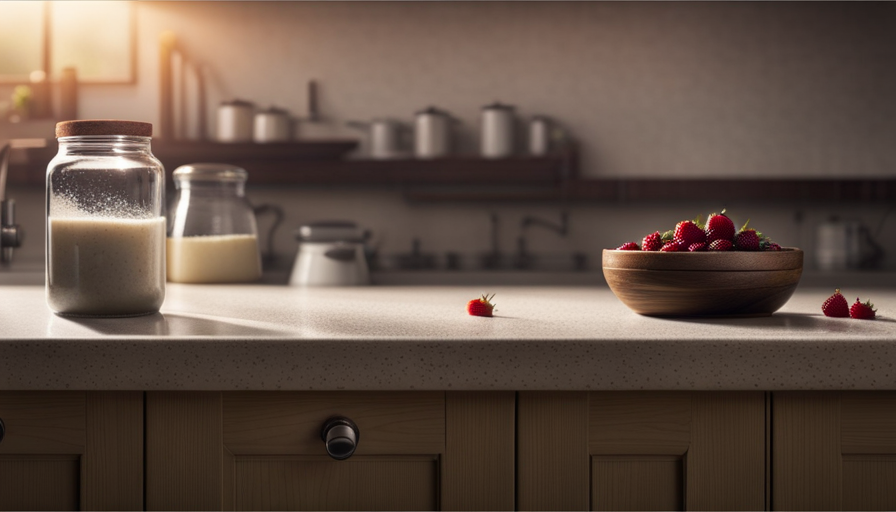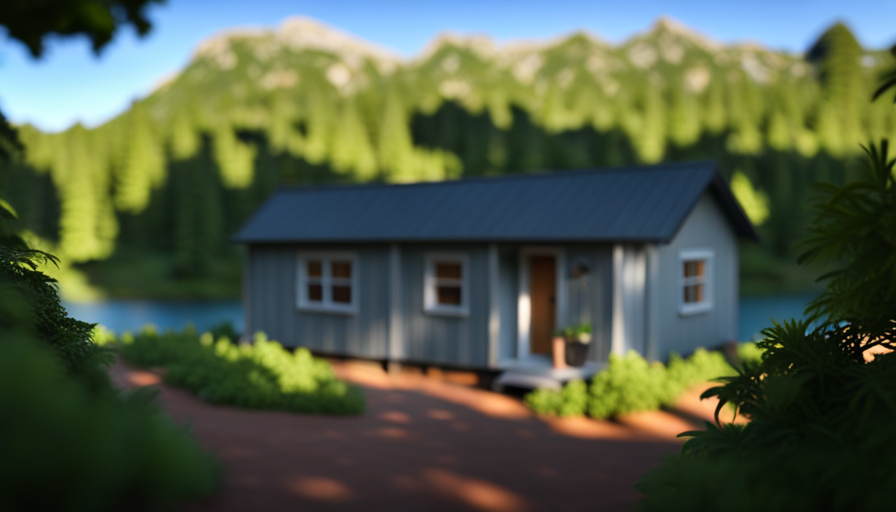As I stepped inside the unassuming exterior of the petite trailer, I was promptly impressed by the innovative layout.
The compact kitchen seamlessly merged with the cozy living area, while the loft above held a surprisingly spacious bedroom. It was clear that the concept of tiny homes on wheels had revolutionized the way we think about living spaces.
But just how large can these mobile abodes be?
In this article, we delve into the world of tiny houses on wheels, exploring the innovative design techniques and clever storage solutions that allow for maximum space utilization. We’ll also discuss the legal considerations and regulations surrounding these unique dwellings.
But perhaps the most intriguing question remains: can a tiny house on wheels be large?
Join me as we push the boundaries and discover inspiring examples of spacious tiny houses on wheels that challenge the very definition of ‘tiny.’ Get ready to be amazed by the possibilities that await within these compact yet expansive living spaces.
Key Takeaways
- Tiny houses on wheels offer freedom, affordability, and sustainability.
- Transportation regulations limit the size of tiny houses on wheels.
- Downsizing to a tiny house on wheels requires careful planning.
- The size of a tiny house on wheels is determined by the size of the trailer and road regulations.
The Rise of Tiny Houses on Wheels
The rise of tiny houses on wheels has revolutionized the concept of homeownership, offering individuals the freedom to live in a compact yet stylish and mobile dwelling. These innovative homes have gained popularity in recent years due to their unique design and the flexibility they provide.
Not only are they an affordable alternative to traditional houses, but they also offer a sustainable living option, reducing the carbon footprint and promoting a more eco-friendly lifestyle.
One of the key impacts of tiny houses on wheels is their effect on the traditional housing market. As more people opt for these mobile homes, there is a shift in the demand for larger, more expensive houses. This trend has allowed individuals to explore the concept of minimalism and downsizing, challenging the notion that bigger is always better. Additionally, the affordability of tiny houses on wheels has opened doors for those who may have struggled to enter the housing market otherwise.
As we delve further into the concept of mobility in tiny homes, we will explore how these dwellings are designed to be easily transported and the advantages they offer in terms of flexibility and adaptability.
Exploring the Concept of Mobility in Tiny Homes
Exploring the concept of mobility in compact dwellings, one must consider the size limitations of these wheeled abodes. Tiny houses on wheels have gained popularity due to their portability, allowing homeowners to easily relocate or travel while still having a place to call home.
However, there are challenges that come with downsizing to such a small space. One of the main challenges of downsizing to a tiny house on wheels is determining how large it can be while still maintaining its mobility. The size of these homes is typically limited by transportation regulations, which vary from place to place.
For example, in the United States, the maximum width for towing a tiny house on public roads is usually 8.5 feet, and the maximum height is around 13.5 feet. These limitations require careful planning and design to ensure that the home is both functional and compliant with the regulations.
To overcome these challenges, innovative design techniques for maximizing space have been developed. These techniques include utilizing multi-functional furniture, such as beds that fold into walls or tables that can be transformed into storage units. Additionally, clever storage solutions, such as built-in shelving and hidden compartments, can help maximize the usable space within the tiny house.
Exploring the concept of mobility in tiny homes involves considering the size limitations imposed by transportation regulations. Despite these challenges, innovative design techniques can be employed to maximize the space within a tiny house on wheels.
Innovative Design Techniques for Maximizing Space
Utilizing clever design techniques, homeowners can create a space within their mobile abode that feels like a spacious oasis despite its compact size. Space-saving innovations and compact living solutions are at the forefront of tiny house design, ensuring that every inch of available space is maximized for functionality and comfort.
One innovative design technique is the use of multi-purpose furniture. By incorporating furniture pieces that can serve multiple functions, such as a sofa that transforms into a bed or a dining table that doubles as a workspace, homeowners can make the most of limited space.
Additionally, utilizing built-in storage solutions like hidden compartments and underfloor storage helps to keep the living area clutter-free.
Another technique is the strategic placement of windows and mirrors. By strategically positioning windows to allow for natural light to flood in, the space feels larger and more open. Mirrors can also be strategically placed to create an illusion of depth and expansiveness.
Lastly, modular design is gaining popularity in the tiny house community. This approach involves using interchangeable and customizable components that can be rearranged to suit individual needs and preferences. Modular furniture, walls, and storage units allow for flexibility and adaptability, making the most of every square inch.
With these space-saving innovations and compact living solutions, homeowners can create a tiny home on wheels that feels spacious and comfortable. As we delve into the subsequent section about clever storage solutions for tiny houses on wheels, we’ll explore how homeowners can further optimize their limited space.
Clever Storage Solutions for Tiny Houses on Wheels
Imagine stepping into a world where every nook and cranny of your mobile sanctuary holds a hidden treasure, cleverly designed to maximize storage space without sacrificing style or comfort. In the realm of tiny house organization, innovative solutions are essential to make the most of every square inch.
One of the key elements in achieving this is space-saving furniture. From foldable tables and chairs to beds with built-in storage compartments, these pieces are designed to serve multiple purposes while taking up minimal space.
In a tiny house on wheels, creative storage solutions are indispensable. Utilizing vertical space is crucial, and that’s where shelves and wall-mounted organizers come into play. These allow for efficient storage of books, kitchenware, and other essentials, while leaving the floor area free for movement.
Additionally, utilizing under-stair storage or incorporating built-in cabinets and drawers throughout the house can significantly increase the available storage capacity.
To further optimize space, multi-functional furniture is a game-changer. For example, a sofa that can transform into a bed or a dining table that can be folded down when not in use. These innovative designs ensure that every square inch of your tiny house is utilized to its maximum potential.
As we transition into the next section about creative furniture and multi-functional spaces, we will explore how these elements can contribute to the overall functionality and versatility of a tiny house on wheels.
Creative Furniture and Multi-functional Spaces
Innovative furniture designs and versatile spaces are key elements for maximizing functionality in a mobile sanctuary. When it comes to tiny houses on wheels, creative furniture and space-saving techniques are crucial for optimizing every inch of the available space. Let’s explore some clever ideas that can transform a small area into a multi-functional living space.
One great example of creative furniture is the convertible sofa. By day, it provides comfortable seating, and by night, it easily transforms into a cozy bed. Another space-saving technique is the use of wall-mounted tables and foldable chairs, which can be tucked away when not in use. These solutions help to create a dining area without taking up valuable floor space.
To inspire you further, here is a table showcasing some innovative furniture designs and their functions:
| Furniture Design | Functionality | Aesthetic Appeal |
|---|---|---|
| Murphy bed | Provides sleeping | Sleek and modern |
| Hidden storage | Hides clutter | Minimalist |
| Loft bed | Creates extra space | Rustic |
| Built-in bookshelves | Maximizes storage | Contemporary |
| Drop-leaf table | Expands dining area | Traditional |
Balancing functionality and comfort in small spaces means finding furniture that serves multiple purposes while still providing a comfortable and inviting atmosphere. Let’s explore how to achieve this delicate balance in the next section.
Balancing Functionality and Comfort in Small Spaces
To find the perfect balance between functionality and comfort in your compact living space, it’s important to consider how each piece of furniture can serve multiple purposes while still creating a cozy and inviting atmosphere.
In small spaces, every square inch counts, so it’s crucial to choose furniture that not only looks good but also serves a practical purpose. Functionality should always be a top priority, but that doesn’t mean you have to sacrifice aesthetics. You can incorporate natural light by strategically placing windows or skylights in your tiny house on wheels. This will not only make the space feel more open and spacious but will also provide a connection to the outdoors.
Additionally, choosing furniture that has built-in storage compartments or hidden features can help maximize the functionality of your small space. For example, a sofa that can be converted into a bed or a coffee table with hidden storage can provide both comfort and practicality.
By carefully selecting furniture pieces that serve multiple purposes and incorporating natural light, you can create a functional and comfortable living space in your tiny house on wheels.
Now, let’s explore the possibilities of expanding the boundaries: how big can a tiny house on wheels be?
Expanding the Boundaries: How Big Can a Tiny House on Wheels Be?
Get ready to push the limits and discover just how spacious and versatile your mobile dwelling can become. When it comes to tiny houses on wheels, there is a growing trend of expanding the boundaries and challenging the conventional size limitations.
Here are four key considerations to keep in mind:
-
Trailer Size: The first factor to consider is the size of the trailer itself. While there are no specific regulations dictating the maximum size, it’s important to ensure that the trailer can safely accommodate the weight and dimensions of the tiny house.
-
Road Regulations: Each state has its own set of regulations regarding the maximum width, height, and length of vehicles on the road. It’s crucial to research and comply with these regulations to ensure safe and legal transportation of your tiny house.
-
Structural Integrity: As the size of the tiny house increases, so does the need for stronger and more durable construction materials. It’s essential to maintain structural integrity and ensure that the tiny house remains stable and secure, especially while on the move.
-
Utility Connections: Expanding the size of a tiny house may require additional space for utilities such as plumbing, electrical wiring, and HVAC systems. Planning for these connections and ensuring they meet code requirements is crucial.
Now that we’ve explored the possibilities of expanding the boundaries of a tiny house on wheels, let’s delve into the legal considerations and regulations for these mobile dwellings.
Legal Considerations and Regulations for Tiny Homes on Wheels
Navigating the legal landscape of mobile dwellings is like embarking on a complex maze, where rules and regulations weave together to shape the future of these compact abodes. When it comes to tiny homes on wheels, there are several legal challenges and zoning restrictions to consider.
One of the main hurdles is finding a suitable location to park or place your tiny house. Many areas have zoning regulations that dictate where and how long a mobile dwelling can be parked. Some municipalities only allow tiny homes in designated RV parks or campgrounds, while others have more lenient regulations.
Additionally, building codes and safety regulations must be adhered to when constructing a tiny house on wheels. These codes ensure that the structure is safe and meets certain standards, such as proper electrical wiring and plumbing. It’s important to consult local building authorities and obtain the necessary permits to ensure compliance with these regulations.
Despite the legal challenges, living in a large tiny house on wheels has its advantages and disadvantages. Transitioning to the next section, it’s important to consider both the pros and cons of this lifestyle choice.
The Pros and Cons of Living in a Large Tiny House on Wheels
Transition: Now that we’ve explored the legal considerations and regulations for tiny homes on wheels, let’s delve into the pros and cons of living in a large tiny house on wheels.
Living in a large tiny house on wheels offers several advantages. Firstly, the extra space allows for more storage options, making it easier to keep belongings organized. Additionally, a larger floor plan can accommodate amenities such as a full-sized kitchen, bathroom, and even a separate bedroom. This provides a greater level of comfort and functionality compared to smaller tiny homes.
However, there are also challenges associated with downsizing into a larger tiny house on wheels. The increased size may limit the number of places you can park or camp, as some areas have restrictions on the dimensions of tiny homes. Maneuvering a larger tiny house on wheels can also be more challenging, especially in tight spaces or narrow roads.
On the flip side, the mobility of a spacious tiny home on wheels offers unique benefits. You have the freedom to travel and explore different locations without sacrificing the comfort of a larger living space. It allows you to embrace a minimalist lifestyle while still enjoying the conveniences of a bigger home.
In the subsequent section, we’ll explore inspiring examples of spacious tiny houses on wheels that showcase the possibilities of living in a larger tiny home while on the move.
Inspiring Examples of Spacious Tiny Houses on Wheels
Imagine yourself stepping into a rolling sanctuary, where every corner is thoughtfully designed to maximize space and create a sense of tranquility. Spacious tiny houses on wheels are becoming increasingly popular, offering a unique blend of mobility and comfort. These inspiring examples showcase innovative designs that prove you can have a roomy living space on a small footprint.
One impressive feature of spacious tiny houses on wheels is their clever interior layout. Architects and designers have found creative ways to utilize every inch of space, ensuring that no area goes to waste. From loft bedrooms to hidden storage compartments, these tiny houses are a masterclass in efficient design. The use of multi-functional furniture, such as folding tables and collapsible beds, further adds to the sense of spaciousness.
Spacious tiny houses on wheels also prioritize natural light and open floor plans. Large windows and skylights flood the living space with sunlight, creating an airy and inviting atmosphere. The seamless flow between the different areas of the house gives the illusion of a much larger space. Clever use of mirrors and light-colored materials also contribute to the overall sense of spaciousness.
The world of tiny houses on wheels is not limited to cramped living spaces. With innovative designs and careful planning, it’s possible to create a spacious and comfortable home on a mobile platform. These inspiring examples prove that size isn’t a constraint when it comes to creating a rolling sanctuary.
Frequently Asked Questions
Are there any legal restrictions on the size of a tiny house on wheels?
Legal restrictions on the size of a tiny house on wheels vary depending on local building codes. These codes dictate the maximum dimensions and weight allowed for a mobile home.
Factors such as road safety, infrastructure capacity, and zoning regulations all come into play. It’s essential to research and comply with these regulations to ensure that your tiny house on wheels meets the legal requirements and avoids any penalties or issues with authorities.
What are some innovative design techniques for maximizing space in a tiny house on wheels?
When it comes to maximizing space in a tiny house on wheels, there are a plethora of innovative design techniques to consider.
Space-saving furniture, such as foldable tables and convertible sofas, are essential for multifunctional areas.
Clever storage solutions, like hidden compartments and built-in shelves, help to optimize every inch of available space.
These design elements ensure that even the smallest of tiny houses can offer functionality and comfort without sacrificing square footage.
How do tiny house owners balance functionality and comfort in such small spaces?
In the world of tiny house living, achieving the delicate balance between functionality and comfort is key. It’s a design challenge that requires ingenuity and resourcefulness.
By carefully selecting multi-purpose furniture, utilizing clever storage solutions, and optimizing every inch of space, tiny house owners can maximize functionality without sacrificing aesthetics.
Additionally, creating a cozy atmosphere involves incorporating warm lighting, soft textiles, and personal touches to make the small space feel inviting and comfortable.
Are there any regulations or considerations to keep in mind when living in a large tiny house on wheels?
When living in a large tiny house on wheels, there are several regulations and considerations to keep in mind.
Firstly, it’s important to check local zoning laws and building codes to ensure compliance.
Additionally, weight restrictions and road regulations must be adhered to in order to safely transport the tiny house.
Living considerations include optimizing space utilization, incorporating efficient storage solutions, and ensuring proper ventilation and insulation.
Adequate plumbing and electrical systems must also be installed to meet safety standards.
Can you provide any inspiring examples of spacious tiny houses on wheels?
They say that good things come in small packages, and when it comes to tiny houses on wheels, this couldn’t be truer. Let me share some inspiring design ideas and creative storage solutions I’ve come across.
From ingenious loft designs that maximize space to cleverly hidden compartments and multipurpose furniture, these spacious tiny houses on wheels prove that size doesn’t matter when it comes to creating a comfortable and functional living space.
Get ready to be amazed by the innovation and creativity of these tiny homes!
Conclusion
In conclusion, tiny houses on wheels have revolutionized the concept of mobility in the housing industry. With innovative design techniques and clever storage solutions, these homes have proven that size doesn’t have to limit functionality. However, it’s important to consider legal considerations and regulations when building a tiny house on wheels.
Interestingly, according to a survey conducted by the Tiny House Community, the average size of a tiny house on wheels is around 200 square feet. This statistic showcases the creative ways in which homeowners have made the most of limited space.
Overall, living in a large tiny house on wheels comes with its pros and cons, but it’s undeniable that these homes offer a unique and sustainable living option.
Hi, I’m Emma. I’m the Editor in Chief of Tiny House 43, a blog all about tiny houses. While tree houses are often associated with childhood, they can be the perfect adult retreat. They offer a cozy space to relax and unwind, surrounded by nature. And since they’re typically built on stilts or raised platforms, they offer stunning views that traditional homes simply can’t match. If you’re looking for a unique and romantic getaway, a tree house tiny house might just be the perfect option.
